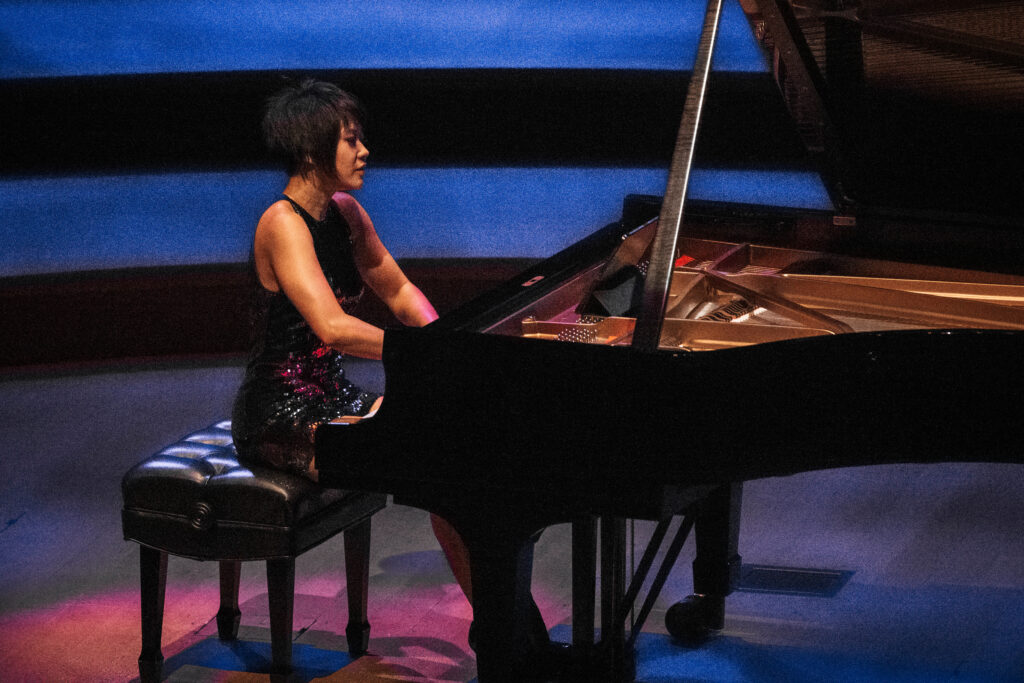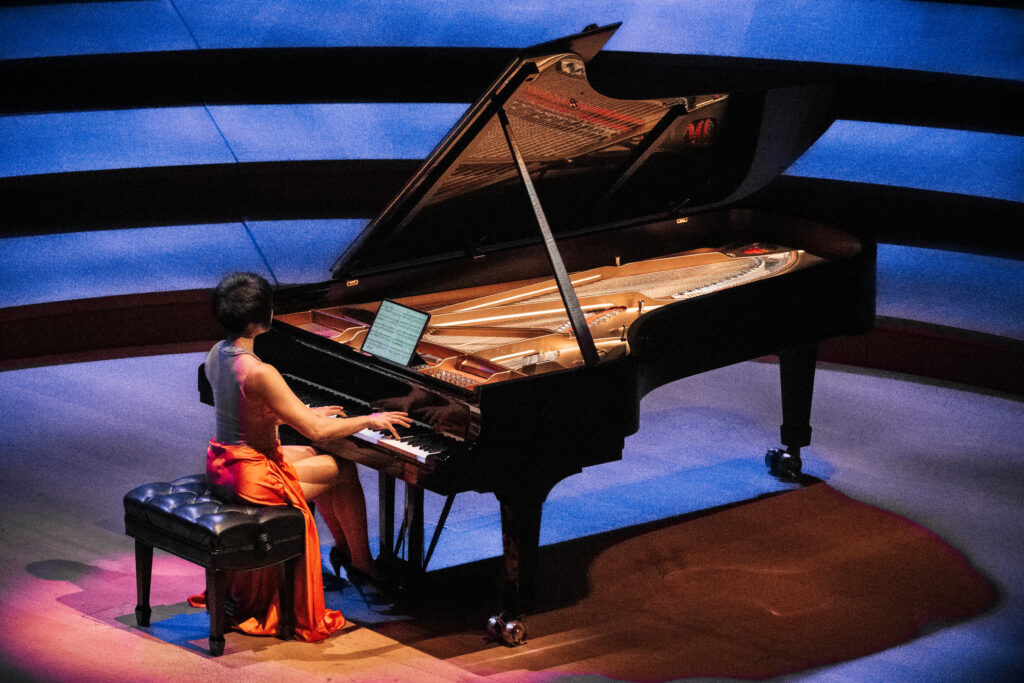
Yuja Wang made her annual pilgrimage to Walt Disney Concert Hall on Mother’s Day, and, no surprise, her recital was a sensation. It was visually and sonically spectacular.
The two halves of her program represented a study in contrasts. The first half consisted of works composed between 1904 (L’isle joyeuse or The Isle of Joy by Debussy) and 1945 (two pieces from Vingt Regards sur l’Enfant-Jésus or Twenty Contemplations on the Infant Jesus by Olivier Messiaen), with the Piano Sonata No. 8 Op. 66 by Scriabin, composed in 1912, in between. The second half consisted of the four Ballades by Chopin.
Of course, one cannot review a Yuja Wang recital without commenting on her apparel. For the first half of the program, Wang appeared in her usual attire: an extremely short dress, this time a sparkling multicolored one with an open back, and spiked heels.
Perhaps because the Messiaen, Debussy and Scriabin pieces were written at about the same time, and two are by French composers, these three works may have sounded similar in their construction to those unfamiliar with them. But they certainly have one thing in common: they gave Wang a chance to showcase her considerable technical talents at the keyboard.
Wang deftly moved from the muted lullaby-like “Le baiser de l’Enfant-Jésus” (“The Kiss of the Infant Jesus”) to the raucous “Regard de l’Esprit de joie” (“Contemplation of the Joyful Spirit”), both by Messiaen, and then on to the lushness of Scriabin’s Piano Sonata.
At one point in the “Regard de l’Esprit de joie,” for what seems like minutes, the piece demands that the pianist’s right hand plays at the very top of the keyboard while the left hand plays at the very bottom, both with intense, percussive energy. It was a sight to behold Wang with her arms outstretched pounding both ends of the keyboard.
At the conclusion of each piece, especially ones as demanding as these, most soloists bow and walk off stage before returning to play the next piece. Not Wang. She performs her customary jerking bow and then sits right back down for the next work. She doesn’t need to rest or recuperate; she’s always ready to go.
After a short intermission, Wang returned to the stage having changed into a tangerine dress. From the back, it was a floor-length gown with a fitted, see-through mesh top. The front featured a dramatic cutaway that, combined with the micro-mini skirt, had the effect of a bathing suit. Of course, the crowd went wild.

In the second half of the recital, Wang played the Chopin Ballades out of order (2, 3, 1, 4), which is not uncommon. However, nothing else about her performance of these masterpieces was common. There are many ways to interpret the Chopin Ballades, and then there is Wang’s way. Each of the Ballades consists of quieter, more melancholy sections followed by explosive sections that require outstanding technical skill. After the first Ballade, the audience must have waited with bated breath for these eruptions, and Wang didn’t hold back, each time displaying her technical command of the keyboard. Let’s just say that these weren’t your father’s interpretations of the Ballades, but they were nonetheless riveting.
Curiously, Wang played the whole concert using an iPad for every piece, it seemed. Perhaps the pieces in the first half are so rarely played that she needed the scores handy. For the encores, she seemed to search through her probably vast repertoire of encores to select the ones she performed.
Wang is famous for performing multiple encores, even after one of the most demanding programs one could imagine, and Sunday night was no exception. Of course, it never hurts that the audience goes crazy for her.
On Sunday night, Wang performed six encores! They included Danzón No. 2 by Márquez (trans. Gómez-Tagle), the Scherzo from the third movement of Symphony No. 6 in B minor Pathétique by Tchaikovsky (trans. Yuja Wang), the Nocturne No. 8 in D-Flat Major, Op. 27, No. 2 by Chopin, the Etude No. 6 by Phillip Glass, the Prelude & Fugue No. 15 in D flat major, Op. 87 by Shostakovich, and A Farewell to Saint Petersburg, No. 10 “The Lark” by Glinka (arr. Balakirev). I’ll just comment on one of the encores.
After the Danzón No. 2 by Márquez, and while the audience was still clapping, Wang launched into her transcription of the Scherzo from the third movement of Tchaikovsky’s Pathétique. In true Horowitzian style, she dazzled with her transcription of the movement, the orchestral version of which ebbs and flows, becoming more and more energetic and almost unruly. Wang’s transcription brought down the house. At that point, she could have ended the concert in a blaze of glory. But no, that was only her second encore.
Wang loves to play the piano, and she obviously loves the adulation from the audience. I would also imagine that she loves to come to L.A. and play at Disney Hall because she performs every year.
To conclude, here’s a little teaser. Next year on Feb. 26, Wang returns to WDCH to perform a piano duet recital with Víkingur Ólafsson — talk about a study in contrasting styles — featuring pieces by Berio, Schubert, Ligeti, Adams and Rachmaninoff.
—Henry Schlinger, Culture Spot LA
For information about upcoming concerts, visit www.laphil.com.
Photo credit: Photographs taken by Timothy Norris at Walt Disney Concert Hall, provided courtesy of the Los Angeles Philharmonic Association





